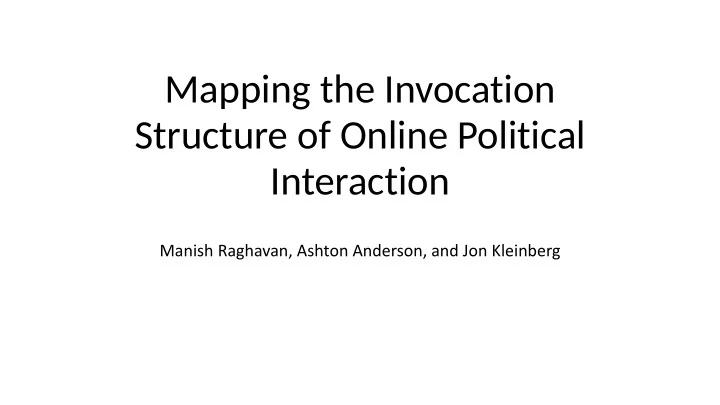

Mapping the Invocation Structure of Online Political Interaction Manish Raghavan, Ashton Anderson, and Jon Kleinberg
Interactions on Twitter Friggeri, Adamic, Eckles, Cheng ‘14: invoked network structure using Snopes replies
Invocation Graph on Domains Could try graph on articles, but in practice too sparse
Invocation Graph Details Key point: linkage reflects use by readers, not hyperlinks by authors Fundamentally different type of network
Invocation Graph Details • Blacklist: youtube.com, facebook.com, … • Politically relevant: high co-occurrence with Clinton/Trump retweets • BFS from known political domain following only edges with large weight • No self-loops
Basic Questions • How are edges arranged in a political sense? • Is linkage symmetric about the political middle? • How does the structure of the graph evolve over time?
Political Spectrum • probability of tweeting URL from 𝑦 𝑄 ( 𝑦 𝐷 ) = given retweet of Clinton on the same day • ( 𝑄 ( 𝑦 𝑈 ) analogous for Trump) 𝑄 ( 𝑦 𝑈 ) [Benkler, Faris, Roberts, Zuckerman ‘17] 𝑡 ( 𝑦 ) = • 𝑄 ( 𝑦 𝐷 ) + 𝑄 ( 𝑦 𝑈 )
Embedding then Invocation Graph on the Political Spectrum 0 1 𝑡 ( 𝑦 )
Concrete Questions • Does linking pattern from correlate with ’s position on the 𝑦 𝑦 spectrum? • Does this change over time? • What symmetries and asymmetries exist in the graph? • Where do edges fall on the spectrum? 0 1 𝑡 ( 𝑦 )
Linking Pattern 𝑦 𝑦 𝜈 out ( 𝑦 ) 𝜈 out ( 𝑦 ) 𝜈 out ( 𝐻 \ 𝑦 ) 1 0 1 0 | 𝜀 out ( 𝑦 ) | • 𝜀 out ( 𝑦 ) = 𝜈 out ( 𝑦 ) − 𝜈 out ( 𝐻 \ 𝑦 ) • Measures how far ’s out-links are from average 𝑦 (positive = right, negative = left) • Correlation with 𝑡 ( 𝑦 ) • Positive (homophily)? Negative (adversarial)? • Change over time?
Correlation between Linking Pattern and Political Spectrum
Change in Correlation over 2016 Working against homophily
Edges Crossing over the Spectrum 𝑔 → ( 𝑧 , 𝐻 ) 𝑔 ← ( 𝑧 , 𝐻 ) 𝑧 𝑧 0 0 1 1 𝑡 ( 𝑦 ) s( 𝑦 ) ^ • Baseline comparison: randomly rewired 𝐻 𝐹 [ 𝑔 ← ( 𝑧 , ^ 𝐻 ) ] 𝐹 [ 𝑔 → ( 𝑧 , ^ 𝐻 ) ] and •
Edges Crossing over the Spectrum
Analogs in other Domains • Political spectrum • Higher rate of cross-ideological interaction leading up to election
Adapting to Reddit r/hillaryclinton r/The_Donald • Too sparse – not enough URL URL → A: … X: … replies B: … Y: … • Alternative: user characteristics C: … Z: … • r/hillaryclinton, r/The_Donald • Sets of active users have small overlap r/politics • Look at interactions in r/politics X: … • Domain frequencies in each subreddit C: … A: …
Comparing Spectra breitbart.com
Comparing Spectra Spearman’s rank correlation = 0.871 (max of 10,000 random permutations = .757)
Cross-Ideological Interactions on Reddit
Comparing Trends
Conclusion and Further Directions 0 1 • Developed techniques to analyze invocation graphs • Built graph based on usage , not hyperlinks r/hillaryclinton r/The_Donald A: … X: … • Uncovered trends leading up to 2016 US election B: … Y: … • Further directions C: … Z: … • Relationship between invocation graph and polarization r/politics • Do trends generalize beyond 2016 US election? X: … • Curated news feeds C: … A: …
Recommend
More recommend